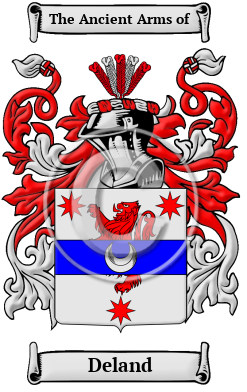| ![Show Contents]() Deland History, Family Crest & Coats of Arms Deland History, Family Crest & Coats of Arms
Etymology of DelandWhat does the name Deland mean? Today's Irish surnames are underpinned by a multitude of rich histories. The name Deland originally appeared in Gaelic as Dubhshlainte. The word dubh means black, and Slaine is topographical; it is Anglicized as Slaney, and may refer to the river Slaney. Early Origins of the Deland familyThe surname Deland was first found in Leinster, where they held a family seat from very ancient times, some say well before the Norman Conquest and the arrival of Duke William at Hastings in 1066 A.D. Early History of the Deland familyThis web page shows only a small excerpt of our Deland research. Another 181 words (13 lines of text) covering the years 1178, 1202, 1685, 1722, 1753, 1764, 1765 and 1797 are included under the topic Early Deland History in all our PDF Extended History products and printed products wherever possible. Deland Spelling VariationsIrish names were rarely spelled consistently in the Middle Ages. Spelling variations of the name Deland dating from that time include Delaney, Delany, Delane, Delaune, Dalaney and others. Early Notables of the Deland familyDaniel Dulany the Elder (1685-1753), Irish-born, prominent lawyer and land-developer in colonial Maryland, who held a number of colonial offices; and his son, Daniel Dulany the Younger (1722-1797), born in Annapolis, Maryland, was a Maryland Loyalist politician and Mayor of Annapolis (1764-1765.) His father sent him to England to be educated, at Eton College and...
Another 55 words (4 lines of text) are included under the topic Early Deland Notables in all our PDF Extended History products and printed products wherever possible.
| Deland migration to Canada | + |
To escape the religious and political discrimination they experienced primarily at the hands of the English, thousands of Irish left their homeland in the 19th century. These migrants typically settled in communities throughout the East Coast of North America, but also joined the wagon trains moving out to the Midwest. Ironically, when the American War of Independence began, many Irish settlers took the side of England, and at the war's conclusion moved north to Canada. These United Empire Loyalists, were granted land along the St. Lawrence River and the Niagara Peninsula. Other Irish immigrants settled in Newfoundland, the Ottawa Valley, New Brunswick and Nova Scotia. The greatest influx of Irish immigrants, however, came to North America during the Great Potato Famine of the late 1840s. Thousands left Ireland at this time for North America and Australia. Many of those numbers, however, did not live through the long sea passage. These Irish settlers to North America were immediately put to work building railroads, coal mines, bridges, and canals. Irish settlers made an inestimable contribution to the building of the New World. Early North American immigration records have revealed a number of people bearing the Irish name Deland or a variant listed above, including: Deland Settlers in Canada in the 19th Century- Patrick Deland, aged 20, a yeoman, who arrived in Saint John, New Brunswick in 1833 aboard the ship "Elizabeth" from Galway, Ireland
- Mrs. Deland, aged 20, who arrived in Saint John, New Brunswick in 1833 aboard the ship "Elizabeth" from Galway, Ireland
| Deland migration to Australia | + |
Deland Settlers in Australia in the 19th Century- Benjamin Edward Deland, aged 25, a carpenter, who arrived in South Australia in 1855 aboard the ship "Warren Hastings"
| Contemporary Notables of the name Deland (post 1700) | + |
- Margaret Deland (1857-1945), née Margaretta Wade Campbell, an American novelist, short story writer, and poet
- Henry Addison Deland (1834-1908), American baking soda manufacturer in Fairport, New York; founder of DeLand, Florida; his home s listed on the National Register of Historic Places
- Josefina "Josephine" Deland (1814-1890), Swedish feminist, writer and teacher
- Pierre Joseph Deland (1805-1862), Swedish actor and theatre director
- Louis Joseph Marie Deland (1772-1823), Swedish ballet dancer, singer, actor, choreographer and ballet master
- DeLand Crary, American politician, Prohibition Candidate for Michigan State Board of Agriculture, 1949; Member of Michigan Prohibition Party State Central Committee, 1951 1
- The Political Graveyard: Alphabetical Name Index. (Retrieved 2015, November 13) . Retrieved from http://politicalgraveyard.com/alpha/index.html
 |

